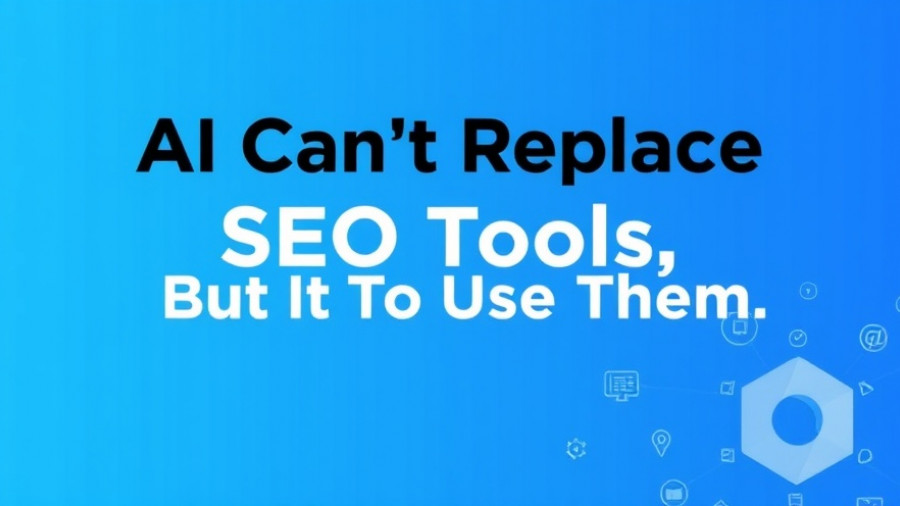
Understanding the Power of SEO Tools
In today’s digital world, small and medium-sized businesses face a formidable challenge: how to navigate the complexities of search engine optimization (SEO) effectively. While the rise of artificial intelligence (AI) tools, like ChatGPT, has generated considerable excitement, it’s essential to discern their real capabilities. Recently, a viral post suggested that these AI tools could replace paid SEO tools altogether, implying a massive annual saving. However, industry professionals quickly countered these claims, underscoring the irreplaceable value of dedicated SEO platforms.
Why AI Can't Fully Replace Dedicated SEO Tools
While AI can simulate some aspects of SEO, such as generating keyword ideas or producing content, it fundamentally lacks real-time access to the vast data required for effective search strategies. Tools like Ahrefs employ extensive web crawling to collect, process, and analyze data from billions of pages to offer insights that AI cannot replicate. This means that, although AI can produce convincing-sounding data, such as estimated monthly searches, it often amounts to guesswork, fundamentally misrepresenting the reality of SEO.
The Role of AI in Enhancing SEO Data Utilization
The good news is that AI doesn’t have to be an enemy to SEO tools. Connecting AI with live SEO data can turn it into a powerful asset for businesses. For instance, the Model Context Protocol developed by Ahrefs enables AI assistants to pull real metrics regarding keyword performance, backlinks, and search traffic directly from reliable databases. This integration allows marketers to make informed decisions based on accurate data rather than relying on the estimations generated by general-purpose AI.
Actionable Strategies for Integrating AI into SEO
Integrating AI into your SEO strategy can be straightforward and beneficial. Start by assessing your current SEO efforts to identify areas where AI can provide assistance, such as keyword optimization or user experience enhancement. Choose the right tools that specifically cater to your needs, ensuring they merge seamlessly with your established processes. Training your team on these advanced tools is crucial, as it empowers them to leverage AI technology instead of fearing it.
Maximizing Business Marketing with a Dual Approach
AI’s real strength lies not in replacing traditional tools but in augmenting them. For example, businesses can use AI-powered analytics to sift through data more efficiently, offering insights into customer behavior that can inform their SEO strategies. This not only enhances targeting but also improves content quality, ultimately leading to better engagement and conversions.
Real-World Example: Building a Competitive Edge
A small business owner may use AI to discover long-tail keywords that are trending within their niche. By leveraging this information alongside the robust data provided by an SEO tool like Ahrefs, they can create tailored content that addresses customer needs—likely enhancing their search visibility significantly compared to competitors who do not use this dual approach.
Future Predictions: The Evolving Landscape of SEO
As AI technology continues to evolve, its integration with SEO strategies will deepen. The synergy of AI and dedicated SEO tools can provide small and medium-sized businesses with a competitive edge, enabling them to tailor their marketing efforts to reach specific audiences effectively. By remaining agile and adaptive, businesses can anticipate and react to changes within the digital marketing landscape, optimizing their outreach and engagement more efficiently than ever.
Conclusion: The Path Forward for Small and Medium-Sized Businesses
In conclusion, while AI may appear to threaten traditional SEO tools, it actually offers a complementary approach that can enhance efficiency and effectiveness when combined carefully. By focusing on integration and application, small and medium-sized enterprises can navigate the complexities of digital marketing successfully. Staying informed about both the capabilities and limitations of AI in SEO will empower businesses to use these tools wisely.
If you're ready to elevate your SEO strategy through the smart integration of AI tools, start by evaluating your current practices and identifying where these technologies can support your growth. Embrace the future of SEO to ensure your business remains competitive in an ever-evolving digital landscape.
 Add Row
Add Row  Add
Add 



Write A Comment